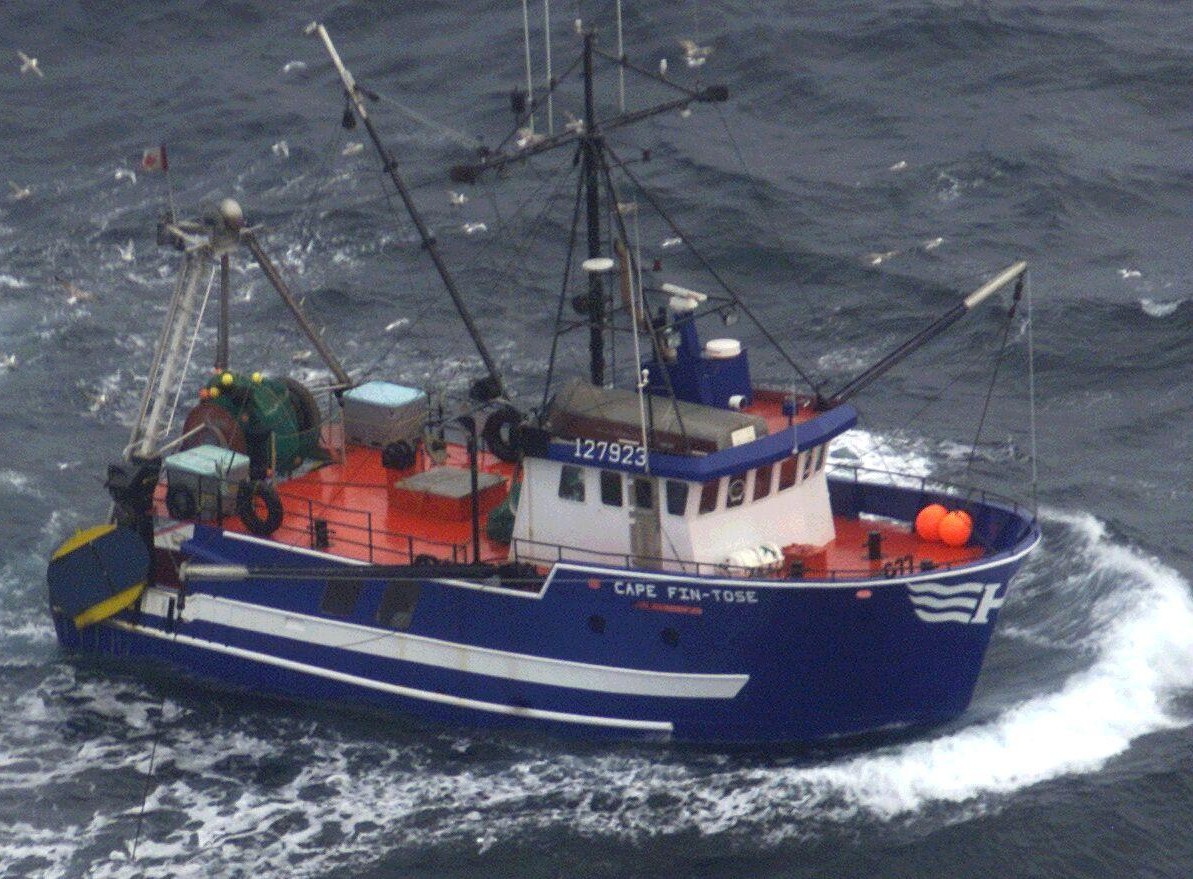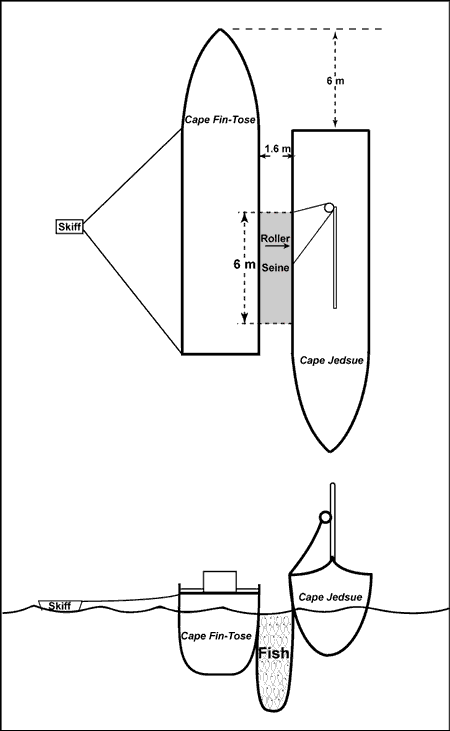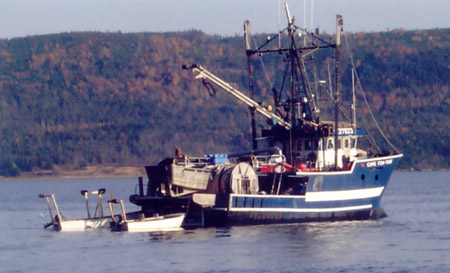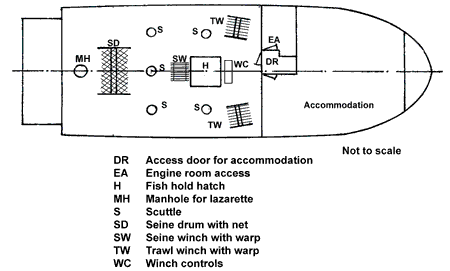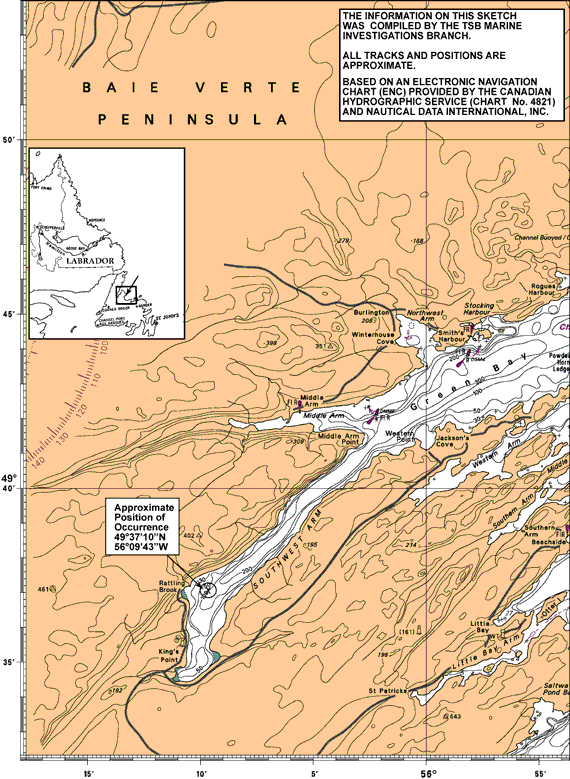Capsizing and sinking
Small fishing vessel Cape Fin-Tose
2.4 nm northeast of King's Point, Green Bay,
Newfoundland and Labrador
The Transportation Safety Board of Canada (TSB) investigated this occurrence for the purpose of advancing transportation safety. It is not the function of the Board to assign fault or determine civil or criminal liability. This report is not created for use in the context of legal, disciplinary or other proceedings. See Ownership and use of content. Masculine pronouns and position titles may be used to signify all genders to comply with the Canadian Transportation Accident Investigation and Safety Board Act (S.C. 1989, c. 3).
Summary
Shortly after 0800 Newfoundland standard time on 01 November 2006, about 2.4 nautical miles northeast of King's Point, N.L., the small fishing vessel Cape Fin-Tose capsized while pumping mackerel from a purse seine belonging to the Cape Jedsue, close alongside. The four persons aboard abandoned the vessel into a small boat tied alongside. The overturned vessel remained afloat for about two hours before sinking.
Factual information
Particulars of the vessel
| Name | Cape Fin-Tose |
|---|---|
| Officiel Number | 809080 |
| Port of registry | St. John's, N.L. |
| Flag | Canada |
| Type | Small Fishing Vessel |
| Gross tonnage | 98.50 |
| Length (overall)Footnote 1 | 19.79 metres (64 feet, 11 inches) |
| Draught | Fwd: 2.74 metres (9 feet) Aft: 3.35 metres (11 feet) |
| Built | 1987, Glovertown, N.L. |
| Propulsion | One Caterpillar 3412 diesel, 466 kW, single propeller |
| Cargo | 63 500 kg (140 000 pounds) mackerel (approx.) |
| Crew | Six |
| Registered owner | LMH Enterprise Ltd., King's Point, N.L. |
Description of the vessel
The Cape Fin-Tose was a small fishing vessel of closed construction, with an all-steel welded hard-chine hull. The hull below the main deck was subdivided by transverse watertight bulkheads, enclosing (from forward) a forepeak, fresh-water and ballast tanks, an engine room with forward fuel oil tanks, a fish hold, and a lazarette with fuel oil and water ballast tanks on each side. Crew accommodation forward and a partial shelter deck aft were located on the main deck. The wheelhouse was located one deck above the accommodation. A single weathertight door led from the accommodation onto the main deck aft.
The Cape Fin-Tose was one in a series of 65-foot fishing vessels, the first of which was built in 1982. Although similar in basic design, various modifications in the arrangement of vessels have been incorporated by individual owners. The Cape Fin-Tose was originally built as a longliner/dragger to fish shrimp, snow crab, and groundfish. In the fall of 2005, the vessel was modified to harvest pelagic fish.Footnote 2 Depending on the fishery, the modifications allowed for the easy removal or installation of the:
- starboard aft section of bulkhead and deckhead
- transom bulwark
- after aluminum "A-frame"
- steel net drum
- trawl doors
- aluminum seine winch
- aluminum seine table
- steel purse winch
On the morning of the occurrence, the vessel was fitted-out to harvest mackerel. The first five items from the list above had been removed and the final three items added.
In August 2005, the vessel owners commissioned a condition survey of the Cape Fin-Tose which concluded in part that "...The vessel was found to be in very good condition and very well maintained."Footnote 3
History of the voyage
At about 1630Footnote 4 on 31 October 2006, the small fishing vessel Cape Fin-Tose departed the vessel owners' wharf in King's Point, N.L. with a crew of six to engage in the mackerel fishery in Green Bay, N.L. At about 0100 on November 1, the vessel started pumping the first set of mackerel from its purse seine into the fish hold. When this operation was completed, the crew stored the vessel's gear, cleaned-up the work area, and prepared to buddy-up with another small fishing vessel, the Cape Jedsue, to harvest its set of mackerel. At about 0530, the Cape Fin-Tose came alongside the Cape Jedsue's seine in a bow-to-stern attitude and made fast the Cape Jedsue's head line to its starboard bulwark on the main deck. The Cape Fin-Tose used its power skiff, with one crew member aboard, to keep the two vessels separated and centred in the bay (see Figure 1).
At about 0600 the Cape Fin-Tose started pumping mackerel from the Cape Jedsue's seine. The original plan had been for both vessels to pump from the seine at the same time. The Cape Jedsue had started hauling in the seine with the net coming over the starboard roller to the power block, but was forced to stop, with the seine still pursed, due to a burst hydraulic hose. The pumping operation went on for about two hours into a pen board-divided fish hold with the Cape Fin-Tose maintaining an even trim throughout the process. As the mackerel were pumped aboard via the main hatch (scuttles were not used), additional pen boards were added until they came within 450 millimetres (18 inches) of the deckhead. At about 0800, as the Cape Fin-Tose was reaching capacity, one of its crew transferred over to the Cape Jedsue to assist with the harvesting of the remaining catch.
Soon after, the Cape Fin-Tose was seen listing to starboard with the after deck starting to submerge. The hatch cover and the weathertight door were open. The vessel immediately stopped pumping operations, but continued to list further to starboard. Realizing that it was about to capsize, the four crew members still aboard abandoned the vessel into a small light boatFootnote 5 tied to the stern, having been unable to completely cut the bulwark lashings to free the net. The crew of the Cape Jedsue, concerned that the Cape Fin-Tose would capsize on top of them, immediately paid-out their seine from the power block, put the wheel hard to starboard, and went full ahead to kick the stern away before finally cutting the seine free of the vessel. The Cape Fin-Tose then capsized and overturned. The speed at which the Cape Fin-Tose capsized, estimated at three to five minutes, prevented the issuing of a distress call, so the Cape Jedsue raised the alert on its behalf.
The four crew members in the small boat went alongside the skiff and the Cape Fin-Tose was let go. They then went to the Cape Jedsue and attempts were made to tow the capsized Cape Fin-Tose without success. After observing the vessel for about an hour, the Cape Jedsue proceeded to the dock at King's Point.
Damage to the vessel
The overturned vessel remained afloat for about two hours before sinking in position 49° 37′10″N, 056° 09′43″W in about 61 fathoms of water.
Environmental impact
Pollution created by the sinking of the Cape Fin-Tose was initially assessed as extensive, but the light sheen on the water quickly dissipated through evaporation and wind/wave action. Impact to the environment was negligible.
Injuries to persons
The four crew members aboard the vessel at the time of the occurrence, the skiff operator, and a sixth crew member who was aboard the Cape Jedsue, were not injured.
Search and rescue
The Cape Jedsue reported the accident to the Marine Communications and Traffic Centre (MCTS) at St. Anthony, N.L., which in turn advised the Marine Rescue Sub-Centre (MRSC) in St. John's, N.L. The CCGS Harp was tasked and arrived on scene at 1500 on November 1.
Since all crew members were immediately recovered by the Cape Jedsue and taken safely to King's Point, no search and rescue services were required.
Vessel certification
The Cape Fin-Tose was last inspected by Transport Canada Marine Safety on 05 August 2004, and a commercial fishing vessel Inspection Certificate (SIC 29)Footnote 6 was issued. The certificate, which was due to expire on 21 July 2008, allowed the vessel to operate on voyages up to Home Trade Class IFootnote 7, but did not allow the vessel to fish for capelin or herring.
Vessel maintenance
The results of an owner-initiated condition survey in August 2005 showed the Cape Fin-Tose to be a vessel "in very good condition and very well maintained." There were no reports of previous water ingress, the deck manhole covers (scuttles) to the fish hold and the lazarette were reportedly well greased and maintained, and the water level alarm for the lazarette did not sound prior to the capsizing. During a search of the Cape Fin-Tose's engine room for a spare hydraulic hose for the Cape Jedsue, no water was present.
Personnel certification
Crew certification for a fishing vessel not exceeding 100 tons, gross tonnage, requires the master or first mate to hold a Fishing Master, fourth-class certificate. The captain held a fishing master, third-class certificate, issued in 2004 (which exceeded the Transport Canada (TC) regulations for the voyage limits of Home Trade Class I), and was certified for the fishing operations being conducted at the time of the occurrence.
Personnel history
The master had 18 years of experience in the fishing industry and 11 years as master of the Cape Fin-Tose. The owner, who was on board as a crew member, had been fishing for approximately 35 years and had owned the Cape Fin-Tose since its construction in 1987.
Weather information
Winds at the time of the occurrence were from the west at 5 knots and sea conditions were calm.
Lifesaving equipment
Lifesaving equipment aboard the Cape Fin-Tose included eight lifejackets, seven immersion suits, an eight-person inflatable liferaft fitted with a hydrostatic release, a six-person boat, two lifebuoys, and one float-free emergency position-indicating radio beacon (EPIRB). In this case, the liferaft could not be released and, although fitted with a hydrostatic release, it did not deploy.
The speed at which the vessel capsized precluded the donning of lifejackets or immersion suits. The EPIRB surfaced and activated shortly after the vessel sank.
Several previous occurrences involving liferafts on small fishing vessels and tugs have resulted in recommendations issued by the TSB. These include:
- ...ensure that liferafts on ...inspected vessels are stowed in such a manner as to permit easy manual launching under distress and any environmental conditions ... (M93-03, issued in March 1993);
- ...initiate research and development into ways of ensuring the accessibility of all emergency equipment, including in a capsized situation (M94-05, issued in February 1994);
- ...the need for liferafts on all vessels to be stowed with a launching system fitted with a release mechanism that allows the inflatable liferaft to be easily released when the vessel sinks (M00-07, issued in March 2001); and
- ...examine the effectiveness of liferaft automatic release mechanisms to prevent premature activation of those mechanisms on small fishing vessels in rough sea conditions (M00-08, issued in March 2001).
In response to these recommendations, TC has initiated research and published Ship Safety Bulletins (SSBs) on the subject and also discussed relevant aspects with the marine industry at (CMAC) meetings. This has resulted in the review of and proposed amendments to regulations. The new Fishing Vessel Safety Regulations, to be published in 2009, will include the requirements for float-free arrangements in the form of a hydrostatic release system or deep chocks. Suitable means of launching a liferaft will also be required. On 02 August 2007, TC issued an updated SSBFootnote 8 that reads in part:
To ensure the float-free capability, liferafts (including those that are davit-launched) should be:
- placed in deep chocks, without lashing, so that they float free automatically if the vessel sinks; or
- secured by lashing fitted with a hydrostatic release unit; or
- placed or secured such that they will automatically float free.
Mackerel
Mackerel typically congregate in large shoals. Unlike other pelagic fish, the mackerel has no swim bladder and must swim constantly to maintain buoyancy and also to provide a constant flow of seawater across its gills to breathe. Large schools of mackerel, when enclosed within a pursed seine, are prevented from swimming and quickly die and sink as the seine is progressively recovered.
Stability requirement
Current requirements
Part I of the Small Fishing Vessel Inspection Regulations (SFVIR) applies to vessels that exceed 15 in gross tonnage, but do not exceed 150 in gross tonnage and that are 24.4 metres and under in length. Under these regulations, vessels of closed construction, built on or after 06 July 1977 and employed in fishing for herring or capelin, are required to have approved stability data on board.
The minimum stability criteria for determining the stability of these vessels is detailed in section STAB 4, of the TC publication Stability, Subdivision & Load Line Standards (TP 7301). Compliance with STA 4 ensures that small fishing vessels maintain what are generally recognized as adequate margins of intact transverse stability throughout a range of standard loading conditions related to the vessel's intended service. However, they do not ensure immunity against capsize regardless of the circumstances, nor take into account any excessive (non-routine) forces suddenly imposed on the vessel during normal fishing operations.
Proposed requirements
Over the years, the subject of small fishing vessel stability has resulted in several recommendations by the TSB. These include:
- to develop and validate more appropriate stability data ... taking into account their characteristics, trade, and conditions in which they operate (M94-30, issued in December 1994);
- to ensure that structural modifications and additions of weights are recorded and accounted for in re-assessing stability of small fishing vessels (M94-32, issued in December 1994);
- to establish guidelines for stability booklets such that information they contain is presented in a simple, clear, and practical format (M94-33, issued in December 1994);
- to require that all new inspected small fishing vessels of closed construction submit stability data for approval (M03-05, issued in November 2003);
- to require all existing small fishing vessels currently without any approved stability data be subjected to a roll-period test and corresponding freeboard verification not later than their next scheduled quadrennial inspection (M03-06, issued in November 2003);
- to reduce unsafe practices by means of a code of best practices for small fishing vessels, including loading and stability, and that its adoption be encouraged through effective education and awareness programs (M03-07, issued in November 2003); and
- to ensure that the Board's previous recommendations M03-05 and M03-06 are immediately implemented (M05-04, issued in November 2005).
In response to the recommendations above, TC has indicated that the new Fishing Vessel Safety Regulations, due to be published in 2009, will address safety equipment, construction, and certain operational issues for small fishing vessels. These regulations will replace the Small Fishing Vessel Inspection Regulations.
TC also recognizes that the fishing industry has become very specialized and certain aspects carry safety risks to vessels and crews. TC is therefore working with the industry to improve matters.
Under the new regulations, fishing vessels exposed to greater risks, as identified by masters and assessed by TC inspectors, will need complete stability assessments. Those at lower risk will be assessed but will have to meet simplified stability and minimum freeboard requirements.Footnote 9
In response to TSB Recommendations M03-05, M03-06, and M05-04, TC issued an interim policy to determine whether a small fishing vessel will require a stability book. Ship Safety Bulletin 04/2006, titled Safety of Small Fishing Vessels: Information to owners/masters about stability booklets, is mandatory for vessels from 15 to 150 in gross tonnage and provides such information to owners/masters and includes a template for "Notes to Masters." Presentations given at the national CMAC in November 2006 discussed, among other issues, educating naval architects on how to pass on useful information to vessel masters.
Stability-related experiment and data
The Cape Fin-Tose had fished for crab, shrimp, and ground fish in the past and was in possession of valid fishing licences. At the time of the occurrence, the vessel was engaged in the mackerel fishery and, by strict interpretation, stability data was not required. On 05 May 2005, despite no requirement to do so, the owner had an inclining experiment carried out to determine the vessel's stability. In August and September 2005, an inclining experiment report and two stability booklets – one for shrimp and crab, and a second for capelin, mackerel, and herring-were respectively produced and submitted to TC for approval.
At the time of the occurrence, the approval for both booklets was pending, but the final results presented in these booklets were compliant with the minimum stability criteria of STAB 4, provided that, when the vessel was employed in catching herring, capelin, or mackerel, the following operational conditions, among others, were met:
- For seining operations, only the two main engine room fuel tanks are to be filled. The two lazarette fuel tanks are to remain empty (Booklet Notes to Master – 4A); and
- During seining, all trawling gear as well as the gantry are to be removed from the vessel (Booklet Notes to Master – 9C).
At the time of the occurrence, the two lazarette fuel oil tanks were roughly 80 per cent full and both trawl winches and warps were still on board.
Occurrence stability
TSB carried out a post-occurrence stability analysisFootnote 10 to assess the transverse stability of the vessel prior to and at the time of the occurrence. Taking into consideration modifications made to the vessel after the most recent inclining experiment done in May 2005 and the fact that the trawl winches and the trawl warps had been kept on board since, current lightship characteristics were determined.
Since the precise quantity of fish and consumables on board at the time of the occurrence could not be established, it was estimated that the fish hold and tanks were loaded as follows:
- Fish hold evenly loaded with mackerel (with a specific gravity of 0.801) at 80 per cent of its capacity;
- Fuel oil tanks aft and forward at 80 per cent and 100 per cent, respectively; and
- Fresh water tank at 25 per cent.
The stability analysis was carried out by simulating various loading conditionsFootnote 11 with the following forces acting on the bulwark: no force, a force of 1 long ton, a force of 6 long tons, and a force of 6.5 long tons.
The results of the calculations for these conditions were compared with STAB 4 and are presented in the following table:
| STAB 4 Minimum Criteria (in tons) |
Magnitude of force acting on the bulwark (in long tons) | |||
|---|---|---|---|---|
| None | 1 | 6 | 6.5 | |
| GMt (transverse metacentric height) (0.35 m) | 0.628 | 0.625 | 0.369 | 0.247 |
| GZ (righting lever) area to 30° (3.152 m-deg.) | 3.146 | 2.545 | 0.29 | 0.098 |
| GZ area to 40° (5.154 m-deg.) | 4.645 | 3.789 | 0.579 | 0.29 |
| GZ area 30° to 40° (1.719 m-deg.) | 1.5 | 1.244 | 0.29 | 0.192 |
| Angle of max. GZ (25 deg.) | 48 | 47 | 49 | 60 |
| Residual freeboard in m (no criteria) | 0.40 | 0.31 | -0.15 | -0.25 |
| Angle of flooding in deg. (no criteria) | 48 | 47 | 45 | 45 |
The results show that the transverse stability characteristics in the condition with no force acting on the bulwark would have almost met the stability criteria of STAB 4. In this condition, the downflooding would occur at an angle of about 48 degrees and the freeboard of the deck at side would be about 0.40 metres (16 inches).
Analysis
Capsizing of the vessel
Due to a mechanical failure aboard the Cape Jedsue, only the Cape Fin-Tose was able to harvest the mackerel. This resulted in a large set of fish being tightly pursed in the seine for several hours. Unable to swim, the mackerel started to die and, as they sank, their combined weight acting against the bottom of the net increased the loading on the net. This loading transferred to the seine head line lashed to the Cape Fin-Tose's starboard bulwark and to the Cape Jedsue's net roller on the main deck's starboard bulwark. This produced a large heeling moment on both vessels, but because the Cape Jedsue had not started loading, this vessel had sufficient stability and reserve freeboard that the effect was far less pronounced.
As the heeling manifested itself very quickly, the crew of the Cape Fin-Tose was unable to completely release the head line and relieve the load on the bulwark. Furthermore, as the Cape Jedsue released the tension of the seine from the power block while manoeuvring to avoid the capsizing Cape Fin-Tose, more weight was transferred to the Cape Fin-Tose's bulwark, thereby exacerbating the situation.
Although the total force exerted on the seine by the fish cannot be precisely calculated, it is estimated that some 18 000-45 000 kg (40 000-100 000 pounds) of mackerel remained in the seine, along with the weight of the seine itself. Therefore, a considerable tipping force (18- 45 long tons) would have been acting on the bulwark of the Cape Fin-Tose and over the roller of the Cape Jedsue. Analysis shows that the transverse stability characteristics of the Cape Fin-Tose would be slightly reduced with, for example, an arbitrary force of 1 long ton acting on the bulwark. This effect would markedly increase with a corresponding increase in force. In this occurrence, it would have only taken a "threshold" force of 6.5 long tons acting on the bulwark to exceed the vessel's heeling moment.
The capsizing was accelerated by downflooding through the open hatch and accommodation door, which occurred at about 45 degrees of heel. It is also likely that some of the fish would have shifted in the hold prior to reaching that angle, further contributing to the capsizing.
Stability Booklet – Notes to Master
Notes to Master 9C, which formed part of the Intact Trim and Stability Booklet for Capelin, Mackerel, and Herring, instructed that "during seining, all trawling gear as well as the gantry are to be removed from the vessel." Although owner-initiated stability calculations for the Cape Fin-Tose were generated with the understanding that the term "all trawling gear" included both trawl winches and warps, this fact was not clearly stated; trawl winches and warps were not removed prior to departure for seining. Similarly, Note 4A, requiring that the lazarette fuel tanks be empty while seining, was not complied with.
Such notes are produced to give the vessel operators guidance for safety and are recommended by Transport Canada in Ship Safety Bulletin 04/2006, pending the publication of the new Fishing Vessel Safety Regulations in 2009.
Liferaft
Although not required by regulation, the Cape Fin-Tose was fitted with an eight-person liferaft, complete with hydrostatic release mounted on the vessel's foredeck. Because the liferaft was susceptible to seas breaking over the bow, two composite lashings consisting of binding straps and crab twine were typically used to secure the raft to the cradle. When the vessel capsized completely, it is likely the hydrostatic release activated, but the liferaft may have been prevented from deploying because the residual buoyancy of the liferaft capsule was insufficient to part the crab twine. It is also possible that the liferaft, like the emergency position-indicating radio beacon, became trapped under the overturned vessel and was prevented from floating to the surface. If this happened, the liferaft capsule would have filled with seawater at some point during the two hours the vessel remained afloat and lost its residual buoyancy. When the vessel finally sank, the liferaft would have sunk as well.
Findings
Findings as to causes and contributing factors
- The vessel was not being operated in accordance with notes included in the (pending approval) stability booklet, in that both lazarette fuel oil tanks were not empty and the trawl winches and warps were still aboard.
- The inability of both vessels to harvest the mackerel from the seine simultaneously prolonged the length of time the fish were captured in the net and the fish likely died.
- When the mackerel in the net started to die, their deadweight acting on the bottom of the net increased the load on the vessel's starboard bulwark.
- The weight transfer as the Cape Jedsue released the tension on the seine net further increased the weight on the Cape Fin-Tose's bulwark.
- The heeling moment exceeded the righting moment and the Cape Fin-Tose capsized.
Findings as to risk
- Although fitted with a hydrostatic release, the liferaft may have been prevented from deploying because it was secured to its cradle with two strap-type bindings. If it did release from its cradle, it probably became trapped underneath the overturned vessel.
- It is likely that the emergency position-indicating radio beacon, which was fitted with a hydrostatic release, released from its enclosure but became trapped underneath the vessel. The deployment and subsequent activation occurred immediately after the vessel sank.
- The speed at which the vessel capsized precluded the donning of lifejackets, the deployment of the liferaft, and issuing a distress call.
Other findings
- Despite the fact that there was no regulatory requirement to do so, the owner had an inclining experiment carried out. Stability data was produced and presented to Transport Canada for approval.
- The requirement, based on the stability book "Note to Master," that all trawling gear was to be removed when seining, did not clearly indicate that the trawl winches and warps should also be removed.
This report concludes the Transportation Safety Board's investigation into this occurrence. Consequently, the Board authorized the release of this report on .
